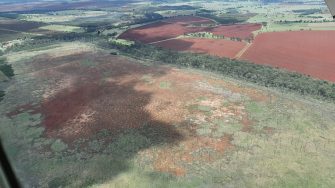
Date: Monday, November 9, 2020
Project: Eastern Australian Waterbird Survey
Observers: Richard Kingsford UNSW, John Porter UNSW/DPIE
Pilot: James Barkell NSW National Parks & Wildlife Service (DPIE)
Instead of heading west, we had to mop up the farm dams that we couldn't count yesterday because of the large storm that hit Charleville on our way in. There was still a fair bit of cloud around as we flew over the Warrego River near Charleville.
Once we had finished surveying those dams we headed east, where there has been extensive clearing. In some places there was also severe gully erosion.
The wetlands between Charleville, Mitchell, Roma and Kingaroy comprised mainly of farm dams, with a few ducks on some but not all of them, including wood ducks, grey teal and black duck. A few of the dams also had pairs of brolgas. I had expected that it might be wetter here, after watching some of the low pressure weather patterns cross central Queensland but it was really dry. Gordonbrook Dam which supplies Kingaroy was well down on its usual levels. There weren’t even the usual number of waterbirds on it. One of the large swamps north of Kingaroy was dry. And the Bjelke-Petersen Dam had hardly any water and as result very few birds, just small flocks of wood ducks.
We finished this Queensland part of the survey and headed to Dalby to refuel before flying on to survey some of the Gwydir wetlands. As it was getting late in the afternoon, we headed to the most westerly wetlands and surveyed back along Mallowa Creek and the Mehi River until we landed in Moree for the night. Both are southwest of Moree. There was very little water in these western wetlands of the Gwydir and only a handful of waterbirds.
Blog by Richard Kingsford
